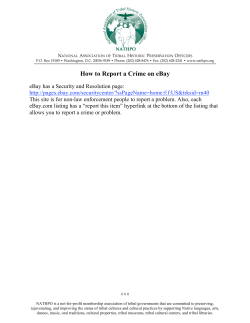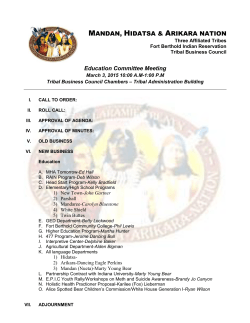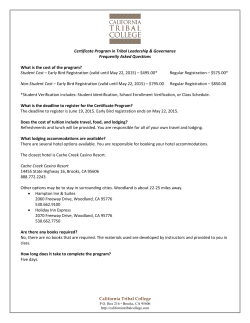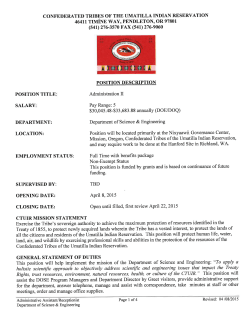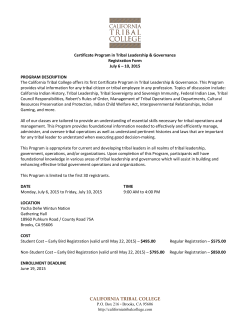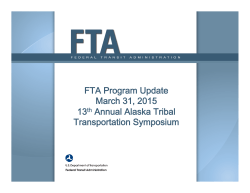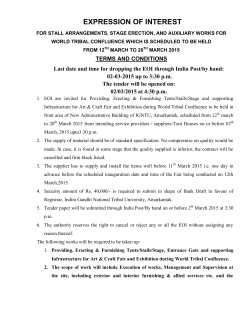
2015 CIIC NatIoNal CoNfereNCe ageNda Monday, april 20, 2015
2015 CIIC National Conference Agenda (Subject to Change) Monday, April 20, 2015 7:00 am CIIC Student Endowment Golf Tournament & Continental Breakfast @ We-Ko-Pa Golf Club (Requires separate registration) 7:00 am - 8:30 am Shuttle service to We-Ko-Pa Golf Club from We-Ko-Pa Resort & Conference Center 9:00am - 3:00 pm CIIC Student Endowment Golf Tournament 9:00am Shotgun Start 1:30pm Post-play Awards Luncheon 10:00 am - 6:00 pm CIIC National Conference Registration Open (Conference Center) 12:00 pm - 4:00 pm CON 101 EXPANDED & ON A NEW DAY! PLAN TO ATTEND! • CON 101: Planning, Design, and Construction (Room 112) How do you get there (a building) from here (an idea)? Construction starts with planning, design, and financing and continues until the structure is ready for occupancy. Tens of thousands of steps are usually required, especially in highly complex buildings; and numerous stakeholders, owners, building end users, architects, contractors, and subcontractors are involved. How does the process begin? What are the different decisions to be made and issues to address? What are the different types of construction? How is technology used? Which areas require involvement by lawyers and regulatory agencies? This session will provide an overview of the evolution of a building project with special focus on unique issues related to building on Tribal lands. AGENDA 1. Registration / Pick Up Packages - 11:30 am 2. Meeting Start - 12:00pm 3. Invocation 4. Announcements; Welcome; Introductions 5. TOPIC 1: RELATIONSHIPS IN INDIAN COUNTRY (a) Guests on The Land (b) Religious & Cultural Implications (c) Challenges / Resolving Disputes (d) Q&A Construction in Indian Country 2015 National Conference Agenda - Subject to Change - Page 1 Monday, April 20, 2015 6. BREAK – 5 Minutes 7. TOPIC 2: LEGAL CONSIDERATIONS (a) The Starting Point: Sovereign Immunity (b) What Standards Apply? (c) Contract Clauses (d) Q&A 8. BREAK – 10 Minutes 9. TOPIC 3: TECHNICAL CONSIDERATIONS (a) Project Delivery Methods (b) Master Planning (c) Incorporating Culture into Design (d) Q&A 10. BREAK – 10 Minutes 11. TOPIC 4: FINANCIAL CONSIDERATIONS / ARRA (a) Understanding Tribal & Industry Financial (b) Bonding Concerns (c) Q&A 12. CLOSING REMARKS / OPEN DISCUSSION / CIIC CENTER 13. BENEDICTION / ADJOURNMENT 5:00 pm - 7:00 pm Welcome Networking Reception (Pool-side) 7:00 am - 5:00 pm Registration Open Tuesday, April 21, 2015 7:00 am - 8:30 am Networking Breakfast (Room 114) 8:30 am - 10:00 am Opening General Session (Room 114) • ASU President’s Office Welcome • Del E. Webb School of Construction Welcome - Dr. Allan Chasey • Construction in Indian Country Opening Remarks • Keynote Address: Empowering the Process: Cultural Frameworks and Indigenous Metrics in the Built Environment - Wanda Dalla Costa, Principal Owner of Redquill Architecture, Inc. Building is a collaborative and complex undertaking. Design and construction of Indigenous environments adds a layer of rigor, but also enriches the process immeasurably, offering valuable lessons in cultural theory, protocol, engagement and practice. A recent project, a K-3 Early Learning Center, opened the dialogue to incorporate an Indigenous worldview. In doing so, two core principles of empowerment emerged: cultural frameworks for Indigenous knowledge systems and Indigenous metrics. 11:00 am - 7:00 pm Tradeshow Floor Open (Room 111) Construction in Indian Country 2015 National Conference Agenda - Subject to Change - Page 2 Tuesday, April 21, 2015 - continued 11:00 am - 1:30 pm Workshop Sessions I • Working with ADOT to Build Pedestrian Access on Tribal Lands (Room 113) Working with ADOT to construct projects is a challenge but can be very rewarding. Knowing in advance what will be required of the Tribe is key in getting the project setup from the beginning in order to have a successful project. We know because we made some mistakes, which have lead to additional fees and extended project schedules, but we have learned from those experiences. In this workshop tribes will learn the common pitfalls that may occur while working w/ ADOT. • The Court Said What??? Recent Court Cases That Impact Construction in Indian Country (Room 112) There is a natural tension in the relationships between Tribal economies, outside vendors, and regulators. In this workshop, a panel of attorneys highlights a few recent court cases that deal with some of these relationships and which may impact construction in Indian Country. • How to Turn a Natural Resource to a Viable Business: Case Study CEB (Room 105/106) This course addresses how to enter into a Tribal natural resources (aggregates, clay, limestone, etc.) business. We will address common questions about the resource, exploration, testing requirements, production, construction and other aspects of the example case study; compressed earth blocks. • Affordable Housing Case Study - Blackfeet Homes (Room 103/104) This workshop will walk participants through the process of developing modern, quality affordable housing. The Blackfeet Housing Authority developed a 24 unit new construction project that completed in 2014. The units are energy efficient and very appealing to new tenants. BHA acted as their own GC, saving cost and giving them absolute control over the process. Together, BHA and TD&CS will discuss the process from initial planning and financing through construction and rent up. • OSHA’s Role in Protecting Native American Workers (Room 102) This presentation will discuss OSHA’s role and jurisdiction on tribal lands, including reporting requirements and training and assistance that is available. We will discuss emerging trends that are based on current accident investigations and will also review areas where jurisdiction and responsibilities may be shared with tribal governments. 12:00pm-1:30pm Luncheon Session (Room 114) • Keynote Address: Defining and Achieving Project Success - Wylie K. Bearup, PE, PhD, Beavers-Ames Professor of Practice & Executive Director of Alliance for Construction Excellence Construction in Indian Country 2015 National Conference Agenda - Subject to Change - Page 3 Tuesday, April 21, 2015 - continued 1:45pm-3:15pm Workshop Sessions II • Planning for Success: Drafting Effective Arbitration Clauses in Tribal Construction Contracts (Room 113) An effective arbitration clause can lead to efficient resolution of the disputes that inevitably arise over construction contracts. In Indian country dispute resolution is complicated by uncertain jurisdiction of courts, sovereign immunity of tribes, and the limited effectiveness of liens on trust lands. The importance of planning for trouble before the contract is signed cannot be overstated. This workshop will address drafting arbitration clauses that do what you want them to do, and actually limit later litigation. • Planning & Organizing for Design & Construction Projects (Room 112) Rider Levett Bucknall in conjunction w/ Summit Project Management have extensive experience in the planning and organizing for design and construction of projects in Indian Country. The proposed workshop will outline the proactive steps that Owners and/or Developers need to consider/implement in our to best plan and organize during the pre-construction phase of any Capital Improvement Project. • An Innovative Approach to Achieve Tribal Health Facilities Development NOW (Room 105/106) Don’t let outdated health facilities compromise your Tribe’s ability to deliver quality health care! Achieve standards of care demanded by the newly competitive health care environment imposed by the Affordable Care Act! Learn how this innovative all-inclusive project development model can help you plan, finance, design, build and operate modern, patient-centered medical facilities to meet the growing healthcare needs of your Tribal members. Learn how other Tribes have successfully leveraged the Joint Venture Construction Program (JVCP) to jump past the decades-long Indian Health Service construction priority list and are now providing the highest quality patient-centric care in state-of-the art facilities for their members. Learn how Tribes can easily obtain and repay financing costs as well as create a long term economic generator for your Tribe through a strategic partnership with an experienced, reputable Tribal Health Facilities Development team. • Indoor Air Quality Solutions for New and Renovated Home Construction (Room 103/104) Indoor pollution sources that release gases or particles into the air are the primary cause of indoor air quality problems in homes. Inadequate ventilation can increase indoor pollutant levels by not bringing in enough outdoor air to dilute emissions from indoor sources and by not carrying indoor air pollutants out of the home. High temperature and humidity levels can also increase concentrations of some pollutants. During building, remodeling or energy efficiency projects in the home air quality can inadvertently be degraded. Understanding and controlling some of the common pollutants found in homes may help improve your indoor air and reduce your family’s risk of indoor air quality (IAQ) related health concerns. There are steps which can be undertaken to minimize pollution from sources inside the home during construction, during everyday living or when undertaking renovation projects. EPA has developed several resources to help reduce the negative impacts of poor IAQ in homes. This interactive session, partici pants will learn about the impacts of poor IAQ, common indoor contaminants and discuss proper solutions. Construction in Indian Country 2015 National Conference Agenda - Subject to Change - Page 4 Tuesday, April 21, 2015 - continued 3:00pm-5:00pm • OSHA’s New Record Keeping and Reporting Requirements (Room 102) In 2015 OSHA revised its record keeping and accident reporting requirements. There is a new list of industries that are now required to keep OSHA accident records. This seminar will review the record keeping requirements and discuss which types of companies are required to keep records. We will also review the new requirements to report all serious injuries to OSHA and discuss the impacts this might have on businesses. Workshop Sessions III • Designing Fitness-Focused Play Environment (Room 113) Fitness focused playgrounds are designed specifically for achieving maximum play value to improve physical strength and sharpen the mind. What is the best piece(s) of equipment to engage the core or elicit multiple muscle groups contracting simultaneously? How can we strategically design a playground that invites children to problem solve and increase peer interaction? How do classic play systems and new trend environments compare and contrast? This continuing education session will provide tips for creating playground designs to get and keep kids active, and help you make a positive and healthy impact on your community. Landscape Structures has been approved as an Authorized Provider by both IACET and LA CES™. We are authorized by IACET to offer .20 CEUs for this session and 1.5 CEUs/Professional Development Units by LA CES. • School Buildings That Tell a Story: Cultural Integration and School Design (Room 112) Native communities are attempting to deal with the intertwined issues of language and cultural preservation while also seeking to provide educational opportunities to their members. Panelists have been chosen for their experience in the planning, design and construction of Tribal related educational facilities that promote 21st century learning and a special connection to the land. They will share their experience, discuss lessons learned and key aspects that influence the successful implementation of culturally sensitive and mission driven schools. Discussion of relevant experience will be placed in the context of best practices and panelists will engage one another as well as the audience in discussion regarding this project type. • Planning and Financing Affordable Housing (Room 105/106) This session will focus on housing needs and wants while also taking into account the availability of funding resources to help bring the various projects to fruition. It will emphasize planning for the short, mid, and long terms so that housing goals and objectives are being met at all stages. There will be some audience interaction to help drive the conversation and make the presentation relevant to its stakeholders. The session will also discuss the Zuni Housing Authority’s strategy on planning and their philosophy on planning and development. Construction in Indian Country 2015 National Conference Agenda - Subject to Change - Page 5 Tuesday, April 21, 2015 - continued • TERO: From the Ground Up and Into the Future (Room 103/104) Our panelists will each bring lessons learned for tribes currently engaged in TERO related projects, processes, and compliance methods. This panel will address opportunities to share their experiences for tribes who are considering, or advancing their TERO programs, and also how that may impact the future growth, experiences, education and employment opportunities of tribal members. One moderator, three panelists. • Protecting Worker from Falls on Residential and Light Commercial Construction Projects (Room 102) Falls from ladders and wood framed structures continue to be a problem in the construction industry. This program will focus on the common violations being cited by OSHA and will review a few of the recent fatalities we have seen in falls from heights under 10 foot, which is a common scenario on residential and light commercial projects. We will focus on discussing the things that can be done to identify and correct these hazards. Tradeshow Networking Reception (Exhibit Hall - Room 111) 5:30pm - 7:30pm Wednesday, April 22, 2015 7:00am-5:00pm Registration Open (Conference Center) 7:00am-8:30am Networking Breakfast (Room 114) 8:00am-2:00pm Trade Show Floor Open (Exhibit Hall - Room 111) 8:30am-10:00am Workshop Sessions IV • Combined Heat Power/Distributed Generation (Room 113) Provide an overview of combined heat and power solutions, including: design and implementation of energy savings projects, energy efficient retrofits, alternative energy integration solutions, efficient power generation systems and energy supply solutions that can be utilized to lower energy costs and increase reliability and security in private, commercial and industrial applications. • BMI: Information Technology in Construction (Room 112) (Description forthcoming) Construction in Indian Country 2015 National Conference Agenda - Subject to Change - Page 6 Wednesday, April 22, 2015 - continued • Indigenous Architecture Process and Principles: A Case Study of the K-3 Aboriginal Learning Center (Room 105/106) Indigenous design thinking is on the rise. Built environments designed in First Peoples communities offer a depth and insightfulness that could inform contemporary architectural theory and practice. This session will investigate the six fundamentals of indigenous space: ideological, spiritual, social, experiential, symbolic and sensory. The Aboriginal Learning Center (Calgary 2016), an innovative urban education project that benefited from extensive community consultations during the design process, will be used to illuminate the six concepts of indigenous space. This session will further investigate the intersection between indigenous and western world-views in creating built environments. The Aboriginal Learning Centre will be used to highlight a cultural frame work for educational environments, with emphasis on the role of sensory, experiential and social factors in design. Parallel contemporary western architectural principles will be examined alongside cultural principles. • Efficiency Opportunities in Tribal Housing (Room 103/104) This workshop is divided into two parts: (1) a presentation of energy efficiency strategies for tribal housing, using the Department of Energy’s Home Energy Saver tool, and (2) a facilitated discussion with the audience to identify and prioritize needs for tribal housing research. In the first half of the session, the presenter will present energy efficiency strategies for tribal housing stock across climate zones, leveraging the Department of Energy’s Home Energy Saver tool. (Note this will not be a full training session but the presenter will introduce the tool and show a few use cases). This section will also present case studies of energy efficiency strategies and other home improvements in that have been successful in various climates and will share best practices based on these case studies with the audience. In the second half of the session, the presenter will facilitate a brainstorming session aimed at determining a research agenda for tribal housing research, including a discussion of potential partnerships and funding sources. • Return to Work Programs: Mitigating Escalating Workers’ Compensation Costs (Room 102) Occupational injuries have vast consequences for companies in the construction industry. The way a company manages these injuries can make a big difference in the claims paid out. Return to work programs can play a big role in a company’s ability to contain these costs. Come hear from a leading expert on how to implement these programs in your company. 10:15am-11:45am Workshop Sessions V • Developing a Workforce Ready Community (Room 113) Working together with local tribal workforce boards and employment agencies to meet the demands of contractors for skilled labor doing construction projects in Indian Country. Construction in Indian Country 2015 National Conference Agenda - Subject to Change - Page 7 Wednesday, April 22, 2015 - continued • Developing Tribal Natural Resources for the Benefits of Tribal Road and Housing Construction (Room 112) This workshop is designed to assist Tribes who wish to utilize native materials for Tribal roads and other construction projects. We discuss different types of construction aggregate, where to find (geologically) those resources, what permits are required, how to mine the material, and business opportunities that arise with the development of Tribal natural resources. This workshop is an excellent natural resource development primer for Roads, Natural Resource, and Business Development Offices to examine the potential benefits of natural resource development. • Financing for Projects on Tribal Lands (Room 105/106) Innovating Financing for Tribal Projects This workshop will highlight a recent case study whereby a large tribal new construction development was financed with multiple financing sources that all tribes can access: 1) USDA backed loan programs 2) HUD leveraging 3) Tribal Economic Development Bonds and 4) Traditional Bank Debt. The discussion will review access, requirements, terms, process, lender profiles and criteria for all tribal financing techniques. An Insider’s Look at Arizona’s Water Infrastructure and WIFA-funded Projects The effective management of water infrastructure is one of the main challenges faced by water systems. Sustainable infrastructure and systems are essential to ensuring the environmental and economic sustainability of communities throughout the nation. To help communities achieve this in Arizona, the Water Infrastructure Finance Authority of Arizona (WIFA) finances design, improvement, construction and acquisition for wastewater and drinking water projects. Utilizing water and wastewater state revolving funds, WIFA provides financial and technical assistance for drinking water and wastewater infrastructure throughout the state. The presentation will provide an overview of WIFA’s programs, highlight why WIFA is a good funding choice for water infrastructure projects and showcase successful projects in Arizona. • Roofing 101: Pros/Cons to Roofing Systems and Proper Maintenance (Room 103/104) While your roof may only be a fraction of your building’s cost, it protects 100% of your assets including employees, equipment, and inventory. Come and learn about the choosing the right roof for your needs and the importance of maintaining your roof system. We will cover the pros and cons of roof systems including single ply, tile, shingles, built up, foam, and metal. Learn about the price, durability, and visual appeal of all roof types. Making the decision of whether to tear off or install a new system over your existing roof can be a tough one. We will provide you with the knowledge needed to make this decision based on your roof ’s existing conditions and your future expectations. Roof maintenance and regular inspections are key to extending your monetary investment and keeping your manufacturer’s warranty valid. We will teach you how to save money in the long term by learning how to properly maintain the current roof system. We will also cover the basics of different roof warranties including what roof repairs are covered and how to keep the warranty valid for its full term. Construction in Indian Country 2015 National Conference Agenda - Subject to Change - Page 8 Wednesday, April 22, 2015 - continued 12:00pm-1:30pm • Using Ergonomic Assessments to Reduce Injuries and Claims (Room 102) Musculoskeletal Disorders account for one third of lost time injuries and workers compensation claims. This includes everything from sprains to back injuries. Learn how ergonomic assessments can be utilized in your workplace to identify the hazards that can lead to these injuries. Luncheon & Closing Session (Room 114) • Keynote Address: (To be announced) 1:45pm-4:45pm OPTIONAL: CLOSING WORKSHOP ON INDIGENOUS KNOWLEDGE & INNOVATION IN THE BUILT ENVIRONMENT • Indigenous Applications in Design Construction: What is Currently Being Done (Room 112) (Description forthcoming) Construction in Indian Country 2015 National Conference Agenda - Subject to Change - Page 9
© Copyright 2025
